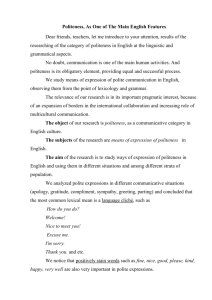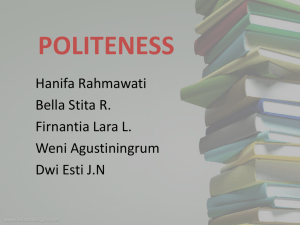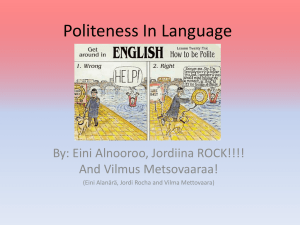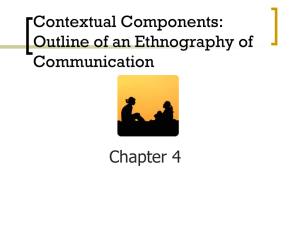Folie 1
advertisement
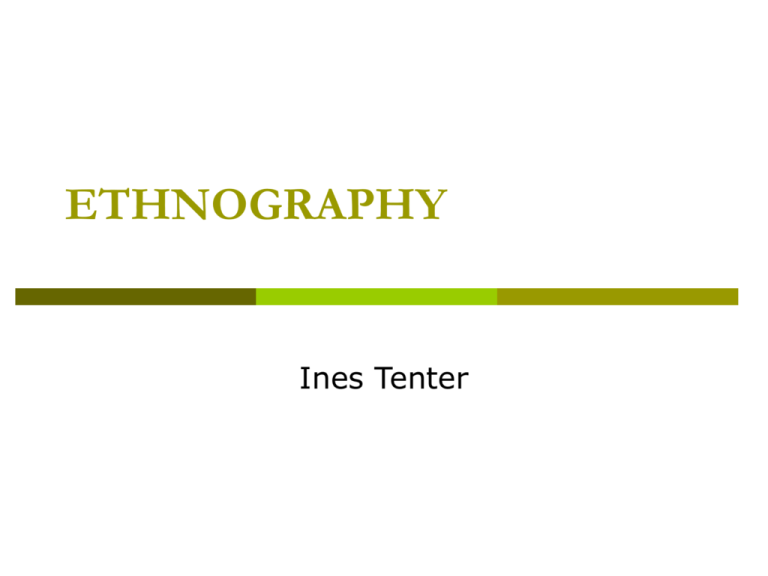
ETHNOGRAPHY Ines Tenter ETHNOGRAPHY Ethnography and its Topics The Rise of Ethnography as a Science Scope and Focus Ethnography and its Significance Communicative Functions Summary Ethnography and its Topics Ethnography includes the following topics: patterns and functions of communication nature and definitions of speech communities means of communicating components of communicative competence relationship of language to world view and social organisation linguistic and social universals and inequalities The Rise of Ethnography as a Science For a long time ethnographers and linguists failed to account for an interrelationship of language and culture Scientist Dell Hymes called for an approach which would deal with aspects of communication which were both: anthropological and linguistic 1962, with the publication of “The Ethnography of Speaking“ Hymes launched for a new disciplin: The Ethnography of Communication (as the field has come to be known) Not much later the Ethnography of Communication has become an emergent discipline, addressing a largely new order of information in the structuring of communicative behaviour and its role in the conduct of social life. Scope and Focus As with any other science, the Ethnography of Communication has two foci: 1. particularistic: is directed towards the description and understanding of communicative behaviour in specific cultural settings generalizing: is directed towards the formulation of concepts and theories upon which to build a global metatheory of human communication 2. Scope and Focus TOPIC QUESTION: (the subject matter of the Ethnography of Communication is best illustrated by one of ist most general questions) What does a speaker need to know to communicate appropriately within a particular speech community, and how does he or she learn? Such knowledge, together with whatever skills are needed to make use of it, is: Communicative Competence Scope and Focus Language is best understood when the: habits customs institutions philosophy (all the subject-matters embodied in the language) are best known. The student of a language should be a student of the people who speak the language! Scope and Focus Middle of 20th century: “Observed behaviour is regarded as a manifestation of a deeper set of codes and rules, and the task of Ethnography is seen as the discovery and explication of the rules for contextually appropriate behaviour in a community or group.“ In other words: Culture is what the individual needs to know to be a functional member of the community. Scope and Focus Doing Ethnography in other cultures involves first and foremost fieldwork: observing asking questions participation in group activities testing the validity of one`s perception against the intuitions of natives Scope and Focus Reveals that many of the communicative practices assumed to be “natural“ or “logical“ are in fact as culturally unique and conventional as the language code itself. Essential feature of all ethnographers: A sense of cultural realtivism Ethnography and its Significance For Antrophology: The Ethnography of Communication extends understandings of cultural systems to language, relating language to: social organisation role-relationship values and beliefs other shared patterns of knowledge and behaviour which are transmitted from generation to generation in the process of socialization/enculturation Ethnography and its Significance For Psycholinguistics: the Ethnography of Communication means that studies of language acquisition must not only recognize the innate capacity of children to learn to speak but must account for how particular ways of speaking are developed in particular societies in the process of social interaction such cross-cultural research requires the openness and relativism of ethnographic methods Ethnography and its Significance For Sociolinguistics: (Sociolinguistics generally involves the recording of naturalistic speech in various contexts) the Ethnography of Communication helps to evaluate the social significance of the material recorded ethnographic knowledge about social norms govering linguistic choices in the situation recorded helps to understand them Ethnography and its Significance For Applied Linguistics: the identification of what second language learners must know in order to communicate appropriately in various contexts contrasting whole communicative systems in cross-cultural interaction and translation recognizing and analyzing communicative missunderstandings knowing possible sactions for various communicative shortcomings Ethnography and its Significance For Theoretical Linguistics: make a significant contribution to the study of universals in language forms and use language-specific and comparative fields of description and analysis its approaches and findings are essential for the formulation of a truely adequate theory of language and linguistic competence Communicative Functions the need to look at the larger socio-political contexts within which culturally situated communication takes place, as these contexts may determine features of communication in ways that are not evident from focus on communicative patterns alone Communicative Functions Examples: Greetings in some languages; e.g.: Korean the greeting may carry crucial information identifying the speakers` relationship Expressions of pain and stress: 1. 2. 3. In English speech communities people learn withdrawel or anger In Japanese nervous laughter In Navajo silence All seems to be culturally patterned! Communicative Functions At societal level language serves many functions: e.g.: creating/reinforcing boundaries unifying its speakers as members of a single speech community excluding outsiders from intragroup communication Certain linguistic features are often employed by poeple, consciously or unconsciously, to identify themselves and others, and thus serve to mark and maintain various social categories and divisions Communicative Functions At the level of individuals and group interacting with one another, the functions of communication are directly related to the participants` purposes and needs: expressive (conveying feelings or emotions) directive (requesting or demanding) referential (true or false propositional content) poetic (aesthetic) phatic (empathy and solidarity) matalinguistic (reference to language itself) For ethnographers, the functional perspective has priority in description Communicative Functions While many of the functions of language are universal, the ways in which communication operates in any one sociesty to serve these functions is laguage specific. The same relative status of two speakers may be conveyed by: their choice of pronominal forms in one language by the distance they stand apart of their body position while speaking in another language and between bilinguals, even by their choice of which language is used to addressing one another Summary How the science of the Ethnography of Communication developed What certain topics it deals with What its significance for other science is That Communicative Functions are culturally patterned The Analysis of Communicative Events Sümeyye Öztürk-Mutlu Grundstudium 2. Semester The Analysis of Communicative Events The ethnographers are interested in identifying recurrent events in community, recognizing their salient components, discovering the relationship among components and between the event and other aspects of society. Types of Data -Background Information: Including settlement history, sources of population, history of contact with other groups and notable events affecting language issue or ethnic relations. -Material Artifacts: Including architecture, signs and such instruments of communication as telephones, radios, books, television sets and drums. Types of Data -Social Organization: Including a listing of community institutions, identities of leaders and office holders, the composition of the business and professional sectors, sources of power and influence, formal and informal organizations, ethnic and class relations, social stratification, and distribution and association patterns Types of Data -Legal Information: Law and court decisions like what constitutes ‘slander’, what ‘obscenity’ and what is the nature and value of ‘freedom of speech’, or how it is restricted. -Artistic Data: Including literary sources (written or oral), song lyrics, drama and other genres of verbal performance and calligraphy. Types of Data -Common Knowledge -Beliefs about Language Use: Including taboos and their consequences, beliefs about who or what is capable of speech, and who or what may be communicated with (e.g. God, animals, plant) -Data on the Linguistic Code: Including study of existing dictionaries and grammars. Survey of Data Collection Procedures These procedures depend on the relationship of the ethnographer and the speech community, the type of data being collected and the particular situation in which fieldwork is being conducted Survey of Data Collection Procedures -Introspection: It is a means for data collection only about one’s own speech community but it is an important skill to develop for that purpose -Participant-Observation: Collecting data in situations in which they themselves are taking part requires ethnographers to include data on their own behaviours in relation to others and an analysis of their role in the interaction as well as those of others. Survey of Data Collection Procedures -Observation: Collecting data which include observation of communicative behaviour with taping, photographing, videotaping and even note-taking. -Interviewing: It may include collection of kinship, schedules, information on important religious and community events and elicitation of folktales, historical narratives, songs, exposition of ‘how to’ in relation to various aspects of technical knowledge and descriptions of encounters among members of the community in different contexts. Survey of Data Collection Procedures -Ethnosemantics: It is concerned primarily with discovering how experience is categorized by eliciting terms in the informants’ language at various levels of abstraction and analyzing their semantic organization, usually in the form of the componential analysis. -Ethnomethodology and Interaction Analysis: It is concerned primarily with discovering the underlying processes which speakers of a language utilize to produce and interpret communicative experiences, including the unstated assumptions which are shared cultural knowledge and understanding. Identification of Communicative Events Analysis of a communicative event begins with a description of the components which are likely to be salient Components of Communication The genre or type of event The topic or referential events The purpose or function, both of the event in general and in items of the interaction goals of individual participants The setting, including location, time of the day, season of year and physical aspects of the situation Components of Communication The key or emotional tone of the event The participants, including their age, sex, ethnicity, social status or other relevant categories and their relationship to one another The message form, including both vocal and nonvocal channels and the nature of the code which is used Components of Communication The message content or surface level denotive references; what is communicated about. The act sequence or ordering of speech acts, including turn taking The rules for interaction or what proprieties should be observed The norms of interpretation, including the common knowledge, the relevant cultural presuppositions or shared understandings. Japanese Marriage Function and Purpose: To declare intention to marry, to establish or develop an appropriate role-relationship Key: Serious Participants: P1-Male; young, adult P2-Female; young, adult Their occupation and status is not relevant Japanese Marriage Message form: Verbal, spoken Japanese, silence Nonverbal, kinesics, eye gaze Message content and sequence: P1 holds P2’s hand (optional), looks at P2 and says ‘Please marry me’. P2 stands with head down, silence Rules of Interaction: A man must propose to a woman at an emotional climax, there should be silence. The woman’s head should hang down and the direction of her eye gaze should be lower than the men’s. Japanese Marriage Norms of the Interpretation: The head of the household is to be man and therefore he has to take the initiative in the decision of marriage. There is also a belief that as soon as an experience is expressed in words, the real essence disappears Marriage is a climax in a girl’s life, its main goal The response is what the young man expects and it confirms that this is indeed the girl he wants for is wife. summary Attitudes toward Communicative Performance Svitlana Sabadash, 2. Semester, MA LN-Haupseminar Questions: → how culture-specific criteria for ‘speaking well’ function in the definition of making of social roles; → how attitudes toward different languages and varieties of language reflect perception of people in different social categories; → how such perceptions influence interaction within and across the boundaries of a speech community. Language attitude studies: those which explore general attitudes toward language and language skills (e.g. which languages or varieties are better than others, to what extent literacy is valued etc.) those which explore stereotyped impression toward language, their speakers, and their functions. those which focus on applied concerns (e.g. language choice and usage and language learning). Attitudes toward language and language skills → Attitudes toward language in general, its nature, and its functions, may be captured by some of the expressions a speech community has that include reference to language. Attitudes toward language and language skills → In many languages, for instance, the ‘heart’ of language is perceived to be the tongue: English: she has a sharp tongue a loose tongue he speaks with two tongues with a forked tongue she spoke tongue in cheek sharp tongue (English) → hot tongue (Dori) → a pointed tongue (Pashto) → hairs on his teeth (German) Attitudes toward language and language skills ‘good’ vs. ‘bad’ speech this doesn’t depend on standardization of a language or a tradition of literacy, although primary valuation of oracy may accompany literacy. A speech community defines on their own the standard of their speaking ‘writer’ vs. ‘orator’ Writing vs. speaking (US President election) Attitudes toward languages and varieties These include: aesthetic/unaesthetic Correct/incorrect Cultivated/uncultivated Developed/undeveloped Effective/uneffective Proper/improper Religious/non-religious Vigorous/non-vigorous Attitudes toward languages and varieties these dimensions refer to both formal and functional aspects of codes, and judgement apply to both multiple language and varieties of a single language. Diglossia and dinomia Diglossia – two or more language in a speech community are allocated to different social functions and contexts Diglossia: (Fishman) both bilingualism and diglossia, diglossia without bilingualism, bilingualism without diglossia and neither bilingualism nor diglossia. Donomia – ‘two systems of laws’ the coaxistens and complementary use within the same society of two cultural systems. Diglossia and dinomia Language CODE Culture Society Diglossia Dinomia Individual bilingualism biculturalism Diglossia and dinomia An each individual represents his/her ethnic and social group. One individual cannot change the whole group attitude (e.g. Language course at US school) Stereotyping Making judgement about people according to linguistic features is a common form of stereotyping; it is possible because of the highly ‘visible’ nature of the markers in language which are correlated with extralinguistic categories in a society, such as race, sex, age, social class, religion, and ethnicity. Social ‘typing’ or categorization is probably a necessary part of our procedures for coping with the outside world. Stereotyping ‘Social structure is the sum total of those typifications and of the recurrent by means of them’ (Berger and Luckmann 967:33) Stereotyping the typing may assume negative aspects, however, and then it ceases to be just a mode of socialization because of their negative connotations and consequences, we might like to claim that stereotypes have no basis at all in observable reality, but they often do. Stereotyping e.g. Jewish speaking in New York is defined as ‘rude’ and ‘pushy’ This is the judgement not how people talk, but about what kind of people they are. Language and identity Each person can identify themselves with a language group by their way of speaking, accents and social behavior. But if a person is bilingual, he or she tends to code-switching. Bilinguals usually speaks one langue better then another, but very often some subjects/topics they know only in one language Learning Language Children start to learn a language from a very beginning as far they can distinguish some sounds. But when can a child become bilingual and which language would dominate in his speaking – decides first of all his speech community. If a child at the age of 2-3 immigrates into another speech community – he intergrades fully into these community. But when a child of 7 would intergrade into another speech community, the probability that his foreign accents would stay is very high. Taboos and Euphemisms Taboos are often a reason of misunderstanding between two persons from different speech communities. To taboos often refers: culture-specific believes, religion, animal-names etc. Euphemisms are serving to soften the verbal impact of dying, death and burial: e.g. is out of his misery, climbed the golden stair Taboos and Euphemisms sleep and rest: laid to rest, called to the eternal sleep departure: crossed over the Great Divide, gone to the Great Beyond occupations: answered the last muster, gave up the ship sports: ran the good race, struck out dead: the deceased, the last lamented Taboos and Euphemisms the cemetery: the Marble City, memorial park the coffin: casket, eternal box the grave: long home, deep six the funeral: planting, cold meat party Taboos and Euphemisms Sometimes some words in one language can be taboo in another. For example, many students learning English as a foreign language refuse to pronounce some words ‘correctly’ because of phonetic similarity to obscene words in their native language (e.g. Turkish speakers do not want to say English peach) Summary: 1 There are many different languages and each of them is unique with its phonetic, lexical and grammatical structure. 2 Each language has its own standards and rules of speaking. 3 Speech community creates it unique specific features like: accent, dialect and special expressions (metaphors, euphemisms and taboos) 4 Every speech community has some ideas of how the other speech community behaves and looks like – stereotyping. Literature: Muriel Sville-Troike: ‚The Ethnography of Communication‘, 1982 Basil Blackwel Ltd. Course: Language and Culture Prof. Dr. Raymond Hickey SS06 Politeness Tugba Akbaba Grundstudium LN Overview 1. 2. 3. 4. 5. Definition of Politeness The politeness principle → Leech`s Maxims Face and politeness strategies FTA`s and politeness strategies by Brown and Levinson : Bald on-record Positive Politeness Negative Politeness Off-record Conclusion What is Politeness ? Statements to `polite` behaviour: “He always shows a lot of respect towards his superiours“ “She is always very helpful and oblinging“ “He always opens doors for the ladies“ etc. Some people: polite behaviour = socially correct others: polite behaviour = stadoffish or incincere The more specific case of `polite` behaviour is `polite` language What is Politeness ? The more specific case of `polite` behaviour is `polite` language - the language a person uses to avoid being too direct - language which displays respect tpwards others - language which contains “polite“ utterances like: please, thank you, excuse me, sorry etc. Some people consider polite language negatively, as `dishonest`, `distant`, `unfeeling` etc What is Politeness ? We have to be polite in different social situations Example: - In a group of friends: “Go get me that plate!“ - In a group of adults at a formal function: “Could you please pass me that plate, if you don`t mind“ Otherwise it would be socially unacceptable, because of the conventional standards of good behaviour → “It costs nothing to be polite“ Churchill Face and Politeness Strategies `Face` refers to the respect that an individual has for him or herself, and maintaining that `self-esteem` in public or in private situation. Any speech act may impose on this `self-esteem` and is therefore face threatening. Speakers have srategies for lessening the threat. Positive politeness: being komplimentary and gracious to the adressee Negative politeness: is found in ways of mitigating the duty Examples: Hedging: Er, could you, er, perhaps, close the, um , window? Apologizing: I'm terribly sorry to put you out, but could you close the window? Impersonalizing: The management requires all windows to be closed. Face Threatening Acts (FATs) & Politeness Strategies (Brown & Levinson) In their theory communication is seen as potentially dangerous and politeness is defined as an redressive action, which reduces this danger. FTAs are acts that infringe on the hearer`s need to maintain his/her self esteem, and be respected. They developed four types of politeness strategies to deal with FTAs : 1. Bald on-record 2. Negative politeness 3. Positive politeness 4. Off-record (indirect) 1. Bald on-record Does nothing to minimize threats to the hearers `face` This typ of strategy is commonly found with people who know each other very well , such as close friends and family. Example: An emergency: Help! Task oriented: Give me those! Request: Put your jacket away. Alerting: Turn your lights on! (while driving) Positive Politeness This strategy shows you recognize that your hearer has a desire to be respected It is usually seen in groups of friends, it tries to minimize the distance between them, by expressing friendliness. Example: Attend to the hearer: "You must be hungry, it's a long time since breakfast. How about some lunch?" Avoid disagreement: A: " What is she, small?" B: "Yes, yes, she's small, smallish, um, not really small but certainly not very big.„ Hedge opinion: "You really should sort of try harder." Negative Politeness This strategy is to assume that you may be imposing on the hearer, therefore this also assumes automatically that there might be some social distance Example: Be indirect: I'm looking for a pen. Request forgiveness: You must forgive me but.... Minimize imposition: I just want to ask you if I could use your computer? Pluralize the person responsible: We forgot to tell you that you needed to by your plane ticket by yesterday. Off-Record (indirect) You take some of the pressure off of you . You are trying to avoid the direct FTA of asking for something Example: Give hints: "It's cold in here." Be vague: "Perhaps someone should have been more responsible." Be sarcastic, or joking: "Yeah, he's a real rocket scientist!" Conclusion We see that polite language is a way of expressing ourselves, which makes it easier for us to deal with other people, because through politeness we build trust Politeness is necessary in our society, because we have to fit to the social norms, otherwise we wouldn`t be accepted But: Just because a person is polite it does not mean he/she has good intentions towards you! Course: Language and Culture Prof. Dr. Raymond Hickey SS06 Disadvantages of Politeness Tülay Sezgin Grundstudium LN Overview 1) Introduction: An example of an impolite behaviour 2) The etymological origins of the terms “polite” and “politeness” 3) Negative aspects of politeness 4) Conclusion 1) Introduction: An impolite Behaviour You are standing in a queue at a coach station waiting for a ticket; someone jumps the queue A feeling of annoyance What we would expect: The official: to point out that there is a queue • Those behind the “jumper“: to start complaining • An excuse of the offender • An explanation for his behaviour: ”I’m terribly sorry. I hope you don’t mind that I have jumped the queue. My coach leaves in five minutes and I desperately need to catch it.” Language behaviour: heart of a social communication Politeness: the crown of social values • 2) The etymological origins of the terms “polite” and “politeness” • • • Link between “polish”, “poli” (Greek: “city”, “polity”) and politizmos (Greek “civilization”). English “polite” and French “poli” lie in the Latin past participle form “politus” and “poli”: “polished” and “to polish”. “Polite” has to do with the etymological roots of police or politics in the Greek “poli” and “politizmos”. 3) Negative aspects of politeness Polite behaviour cannot always be regarded as a positive thing • Relegation of own interests in favour of a social • Group • Feeling of resentment Problem: If we put ourselves into the background of other members of a social group, how do we know that others will also do the same? More negative aspects: • • • • • • Oppressive force Taming of the individual Imposing deference and conformity Altruistic intentions Deceptive lie Convenient mask Other questions of politeness • • How far can we go with these actions before others begin to take advantage of us? Would it be easier to do what is to our advantage and disregard other feelings and interests? Conclusion Language and forms of language behaviour are the heart of social communication Politeness: the crown of social values Including oppressive forms, deception and altruistic intensions References: Watts, Richards J. 2003: “Politeness”. Cambridge [u.a]: Cambridge Univ. Press. Course: Language and Culture Prof. Dr. R. Hickey SS 06 The concept of politeness: American English vs. Japanese Özlem Ögredici Grundstudium LN Overview Negative and positive politeness (Brown & Levinson) Differences of Politeness in American English and Japanese General assertions TLN (title plus last name) vs. FN (first name) Employment of compliments/responses to compliments Conclusion Negative and positive politeness (Brown & Levinson 1978) Positive politeness: directed toward S's need for approval and belonging; expresses solidarity; using in-group markers, being optimistic, indicating common ground, and offering or promising; American speaker: “Your hair looks nice today.” positive Negative politeness: being conventionally indirect, questioning, hedging, being pessimistic, minimizing the imposition, giving deference, and apologizing; increases when S is less powerful or familiarity is low; attempt by the speaker to save the listener’s face by engaging in some formality or restraint. Speaker: “Do you like my new haircut?" American speaker: “It looks great!” (but the true opinion is that the haircut looks terrible) negative Differences of politeness in AE and Japanese Politeness in Japanese: Differences in social status and power are clearer and more important in Japan. The Japanese language supports this system. “Keigo” (special polite language) used to show respect when speaking to superiors or people outside of one's own group. It is more polite to keep others outside of the group. The Japanese acknowledge superiority more clearly and usually use negative politeness to people outside their groups. Examples: they apologize to maintain a good relationship, even when he/she is not wrong (negative politeness) or they disagree or criticize, he/she does so very indirectly (negative politeness). Differences of politeness in AE and Japanese Politeness in American English: Social status and power are not so clear and less important than in Japan. Americans use more positive politeness than Japanese. For Americans, it is polite to include other people in one's own group by use of informal language. Differences of politeness in AE and Japanese TLN vs. FN by Americans and Japanese: TLN (title plus last name): formal and polite form used for address to convey a polite or formal attitude of the S; FN (first name): informal and casual form which conveys a friendly attitude of the S; By Americans: “polite” and “friendly” are similar concepts and often used together; easy to switch from TLN to FN; not a great offence to use FN to address a person to whom polite or respectful attitude is expected; By Japanese: “culture”, “polite” and “friendly”=discrete concepts. Japanese (who speaks English) keeps distinction between TLN and FN form; oversensitive to politeness distinctions; using FN (like an American) means to learn the American structure of “polite” and “friendly”. Differences of politeness in AE and Japanese Employment of compliments/responses to compliments: Compliment is a form of positive politeness. Accepting the compliment Returning the compliment Thanking and denigrating Deflecting Rejecting the compliment American Yes (39.3%) Yes (18.5%) No Yes (29.5%) Yes (12.7%) Chinese Yes (1.0%) No Yes (3.4%) No Yes (95.7%) American speakers were found to engage in deflection responses (e.g. "Did I really do that well?”). Chinese speakers frequently responded to compliments with rejection followed by self-denigration (Chen, 1993). Differences of politeness in AE and Japanese Japanese speakers exhibit a similar pattern like the Chinese speakers: use compliments by downgrading oneself or comparing oneself negatively (approach to negative politeness); Tend to compliment appearance as well as abilities (also the case among Americans) Similarity between JSs and AESs: the primary function of compliments to generate harmony or solidarity Difference: the response to compliments95% of the responses among JSs showed a “self-praise avoidance”; only 5% showed appreciation; JSs seldom compliment own family (not the case among Americans) Indicates function of downgrading oneself” family in Japan is part of one’s self; Conclusion Criteria of politeness Speakers Japanese speaker American speaker Social status and superiority Important, clearly distinguished Less important, no clear distinction Negative politeness Often used; especially when S is inferior Seldom used Positive politeness Very seldom used; JSs have problems with it; Often used; no problems Integration of other people Polite to keep other people outside the group Polite to include other people Polite TLN vs. friendly FN “Polite” and “friendly” are different concepts; distinguished clearly “Polite“ and “friendly” almost the same; switching allowed Compliments Used by downgrading or comparing oneself negatively Accepting and returning; deflection responses; own family References Books: • Watts, Richard J. (ed.) 2005: “Politeness in language”. Berlin [u.a]: Mouton de Gruyter. Garcia, Ofelia (ed.) 1989: “English across cultures, cultures across English”. Berlin [u.a]: Mouton de Gruyter. Internet: www.studentorgs.utexas.edu/flesa/tpfle/contents10.doc www1.doshisha.ac.jp/~kkitao/library/article/polite2.htm Thank you for your attention... …and don’t forget to be polite...PLEASE!



